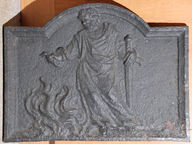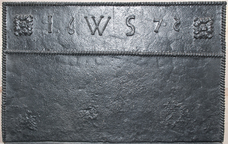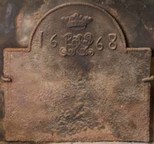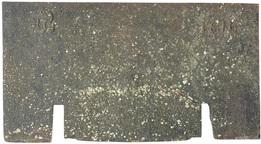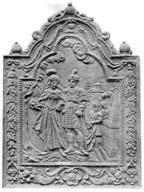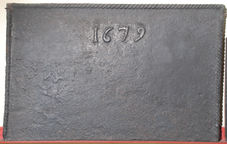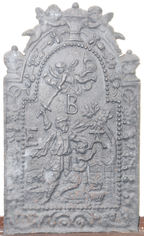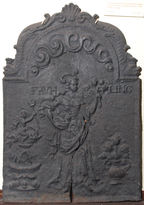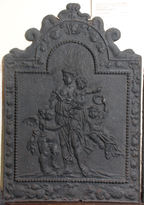-
162
Description: Arched rectangular shaped; cavetto-moulded edge; figure of St Paul, a sword in his left hand, holding a viper in his right hand over flames rising from the ground.
Notes: The scene illustrates an episode in the New Testament, Acts 28: 3. The design shows stylistic similarities to other firebacks where simple, well-executed relief has overlapped the cavetto edging. Formerly part of the Ade Collection (from Grove Hill, Hellingly, Sussex).
Copies of this fireback are known.
- Decoration tags:
- rectangular with round arch (shape)
- cavetto (edging)
- whole carved pattern
- pictorial
- biblical
- humans
Manufactured: in the mid- to late-17th century possibly in the Weald area of England.
Current location: Hastings Museum and Art Gallery, John's Place, Bohemia Road, Hastings, East Sussex, England.
Museum number: HASMG: 1952.51.25 (part of the Hastings Museum museum group)
Citation: Butterfield, W. R., 1916, 'Old Wealden Firebacks', The Connoisseur, 46, pp. 197-209.
- Attached to series:
- Small cavetto series
- New Testament firebacks
-
1271
Description: Rectangular shape; twisted rope edging (top and sides only); central initials, WS, in different character sets, between split date, also in different numeral sets, with a rectangular floral patera repeated at each end; below, and at a slight incline to the right, a horizontal twisted rope dividing the plate. The '5' of the date has been stamped in reverse.
Notes: A boldly cast fireback with disparate character styles. Probably acquired for the castle in the early-20th century during its refurbishment for Edward Hudson by Edwin Lutyens.
Inscription: 1 6 W S 7 5 [5 reversed]
- Decoration tags:
- rectangular (shape)
- rope (edging)
- simple stamps
- carved stamps
- individual letters
- individual numbers
- text
- plants
Manufactured: in 1675 in England.
Current location: Lindisfarne Castle, Holy Island, Northumberland, England.
Museum number: 511616 (part of the National Trust museum group)
- Attached to series:
- Miscellaneous stamp firebacks
-
1225
Description: Arched rectangular shape; twisted rope edging (top and sides); in arch, marquess's coronet above a monogram with date split either side.
Notes: The elaborate monogram has not been deciphered, but the fireback does not appear to be related to the Talbot family who owned Lacock throughout the 17th century.
Inscription: 16 [undeciphered monogram] 68
- Decoration tags:
- rectangular with round arch (shape)
- rope (edging)
- whole carved pattern
- individual numbers
- heraldic
- monogram
- text
Manufactured: in 1668 in England.
Current location: Lackock Abbey, Lacock, Wiltshire, England.
Museum number: 996713 (part of the National Trust museum group)
- Attached to series:
- Miscellaneous pattern firebacks
-
1309
Description: Rectangular shape; no edging; top left, inverted 'renaissance' shield with the initials M above IE; top right, date 1671 in unseriffed numerals.
Notes: The shield with initials has not been noted on another fireback. The slots in the fireback are to accommodate andirons or firedogs.
Inscription: IME [triad] 1671
- Decoration tags:
- rectangular (shape)
- none (edging)
- carved stamps
- individual numbers
- text
Manufactured: in 1671 in England.
Current location: Lay's Auctioneers, Alverton Road, Penzance, Cornwall, England.
- Attached to series:
- Date & initials firebacks
- Andiron slot firebacks
-
863
Description: Arched rectangular central panel with additional arch above; bead and fillet edging; pictorial scene of, on the left, a tree next to a female and, in the centre, a male figure, both in eastern dress, a page behind holding a train, and to the right a short obelisk surmounted by a crescent, behind which is the head of a figure with a camel; behind is a small building also surmounted by a crescent, with clouds above; the word, ASIA, is centre bottom; identical shaped border with cavetto-moulded edging; a pomegranate on top with descending swags of drapery; at the sides, overlapping bunches of foliage suspended from ribbon bows; at the bottom, a central cartouche between fruit bunches; on top, a pomegranate with a descending serpent on each side, and a pomegranate on each shoulder of the plate.
Notes: A pastiche of the EUROPA design based on an engraving c.1642 of Friedrich Wilhelm, Elector of Brandenburg, and his wife, Luise Henriette of Oranje-Nassau, by Mathias Czwiczek, with the figures adopting very similar poses in an oriental setting; one of a series depicting allegories of the four continents.
Copies of this fireback are known.
Inscription: ASIA / MB
- Decoration tags:
- 'Dutch' (shape)
- cavetto (edging)
- whole carved pattern
- pictorial
- allegorical
- monogram
- text
- humans
Manufactured: in the mid- to late-17th century possibly in the Siegerland area of Germany.
Current location: not known.
- Attached to series:
- 'Dutch' Arched arch types
- 'Dutch' Continents firebacks
-
386
Description: Rectangular; twisted rope edging on top and sides; date placed centrally near top.
Notes: A similar fireback with slightly different proportions has the same date using the same numerals. Formerly at the Anchor Hotel, Eastbourne, Sussex.
Inscription: 1679
- Decoration tags:
- rectangular (shape)
- rope (edging)
- carved stamps
- individual numbers
- text
Manufactured: in 1679 in the Weald area of England.
Current location: Anne of Cleves House, Southover High Street, Lewes, East Sussex, England.
Museum number: LH000.910 (part of the Sussex Archaeological Society museum group)
Citation: Dawson, C., 1903, 'Sussex Iron Work and Pottery', Sussex Archaeological Collections, 46, pp. 1-54.
- Attached to series:
- Date only firebacks
- 1679 Wealden series
-
409
Description: Quasi-arched rectangular shape, semi-circular protrusions on top corners; circular loop at top of arch; fillet edging with small twists inside arch, and curls inside and below top corners; a phoenix in flames, its wings displayed and inverted.
Notes: The use of the loop in the edging draws comparisons with other firebacks, and may indicate the same source. Formerly part of the J. H. Every collection.
- Decoration tags:
- rectangular with round arch (shape)
- fillet (edging)
- whole carved pattern
- planklines
- pictorial
- mythological
- animals
Manufactured: in the mid- to late-17th century possibly in the Weald area of England.
Current location: Anne of Cleves House, Southover High Street, Lewes, e, England.
Museum number: 1944.24.061 (part of the Sussex Archaeological Society museum group)
- Attached to series:
- Loop edged firebacks
- Phoenix firebacks
-
413
Description: Arched rectangular central panel with bead edging; standing figure of Abraham about to sacrifice a kneeling Isaac, Abraham's raised right hand holding a sword is retrained by an angel; behind Abraham is a ram; initials are placed in a triangle above behind and in front of the group; arched rectangular border with fillet edging and descending floral and fruit bunches on a ribbon, hanging from rings, foliate swirls at base; vases on rectangle shoulders and at top, between two putti
Notes: The initials appear to have been added subsequently.
Inscription: B / E A
- Decoration tags:
- 'Dutch' (shape)
- fillet (edging)
- whole carved pattern
- individual letters
- pictorial
- biblical
- text
- humans
Manufactured: in the mid- to late-17th century possibly in the Siegerland area of Germany.
Current location: Anne of Cleves House, Southover High Street, Lewes, East Sussex, England.
Museum number: LH000.946 (part of the Sussex Archaeological Society museum group)
-
419
Description: Arched rectangular central panel with cavetto-moulded edging; standing female figure holding a bunch of lowers in her left hand and a pot of flowers in her ight hand; to her left a ribbed, two-handled vase of tulips, to her right a fountain with a seated figure of Neptune/Poseidon holding a trident in the right hand; the words, Fruhling, split by the figure; above, clouds; on top a scallop shell between two descending sea serpents.
Notes: An iconic personification of Spring. Formerly at Swanborough Manor, Sussex.
Copies of this fireback are known.
Inscription: FRVH LING
- Decoration tags:
- 'Dutch' (shape)
- cavetto (edging)
- whole carved pattern
- pictorial
- allegorical
- text
Manufactured: in the mid- to late-17th century possibly in the Siegerland area of Germany.
Current location: Anne of Cleves House, Southover High Street, Lewes, East Sussex, England.
Museum number: LH000.909 (part of the Sussex Archaeological Society museum group)
Citation: Dawson, C., 1903, 'Sussex Iron Work and Pottery', Sussex Archaeological Collections, 46, pp. 1-54.
- Attached to series:
- 'Dutch' Miscellaneous Firebacks
-
423
Description: Arched rectangular central panel with bead edging; standing female figure, classically dressed, holding a child in her arms, another child holding a wreath, seated to her left, and a putto standing to her right; arched rectangular border with fillet edging; mask top centre with descending floral bunches on ribbons, with a cartouche centre bottom; on top, two symmetrical descending serpents.
Notes: The figure represents Charity, one of a several iconic figures portrayed on firebacks of this period.
Copies of this fireback are known.
- Decoration tags:
- 'Dutch' (shape)
- fillet (edging)
- whole carved pattern
- pictorial
- allegorical
- humans
Manufactured: in the mid- to late-17th century in the Siegerland area of Germany.
Current location: Anne of Cleves House, Southover High Street, Lewes, East Sussex, England.
Museum number: LH000.947 (part of the Sussex Archaeological Society museum group)
- Attached to series:
- 'Dutch' Miscellaneous Firebacks
- Charity firebacks
